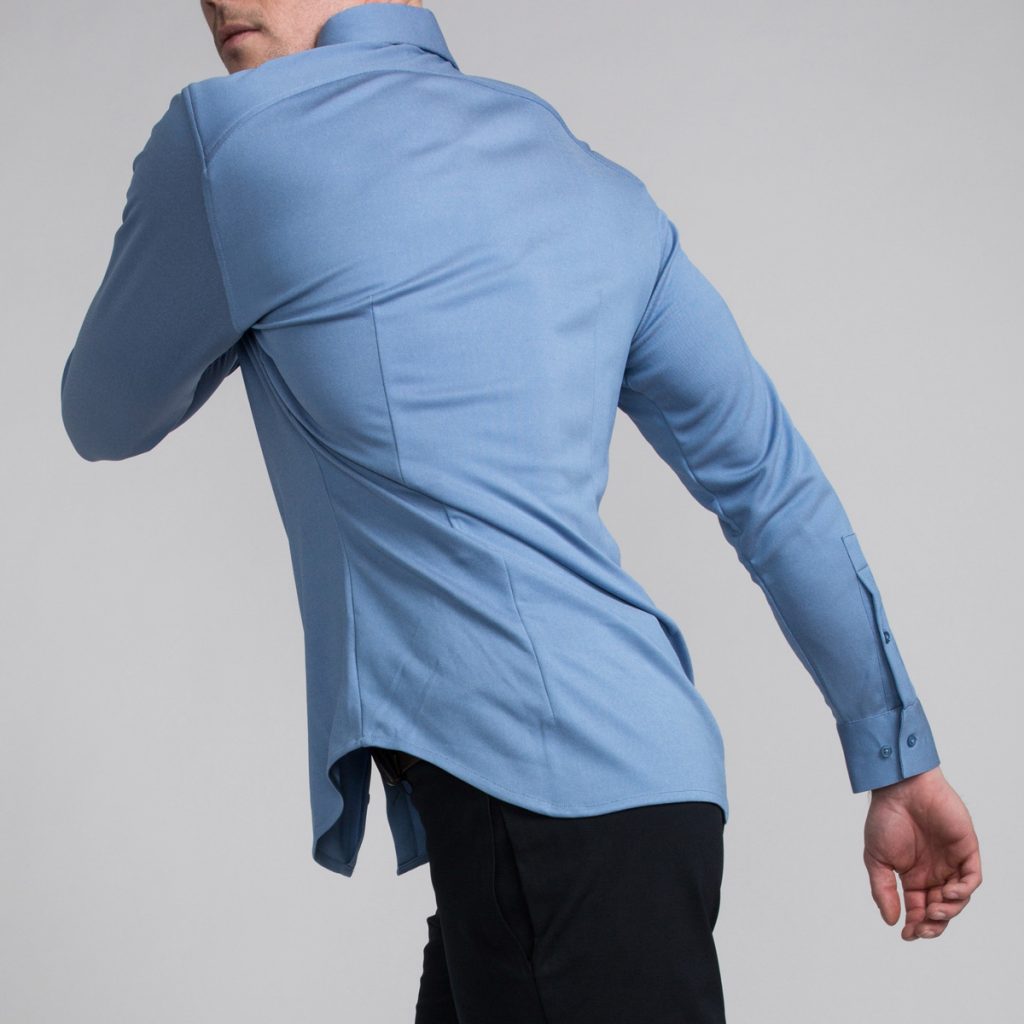PERFORMANCE ISSUES: HIGH-TECH FIBERS GO MAINSTREAM ON THE MAIN FLOOR

Do a little online shopping these days, and you might come across a product description that reads like this: “…triggered by your body’s temperature to either warm or cool itself depending on the situation…designed to retain heat to keep you warm when no moisture is present…absorbs odor molecules…stretch-mesh fabric is integrated throughout to ensure maximum mobility and comfort.” You’ll be forgiven for thinking the copy was used to describe a pair of running shorts or a golf shirt. In fact, these selling points were lifted from the hangtag of a suit from the Kenneth Cole Awear-Tech collection at Men’s Wearhouse. Sportswear brands like Tommy Bahama are incorporating 37.5 Technology to help regulate core temperature in polo shirts carried at Nordstrom (the tech also has been used in Kenneth Cole footwear and Daniel Hechter clothing). JCPenney’s J. Ferrar dress shirts now feature Coolmax technology, and Haggar pants at Macy’s are moisture-wicking.
Now that today’s customer has become acclimated to everything from stretch to Dri-Fit to Coolmax to durable water repellent (DWR) coatings as a result of forays into the athletic and outdoor markets, it was only a matter of time before these fibers, treatments, and technologies made their way into apparel he wears every day. And its apparel that not only has to perform, it must also be good for the planet!
“For spring 2020, in particular, Peerless is using performance fibers and features in all our tailored clothing brands,” says Eric Jennings, fashion director. “We know there’s a whole new generation of guys who grew up wearing athletic performance sportswear but are now buying tailored clothing. They expect that their suits should feel the same way and have the same qualities: stretch, breathability and thermal regulation.”

Online retailer Ministry of Supply (MOS) set out to create what it refers to as the “performance professional” category, reinventing classic styles by using high-tech fabrics and engineering. “When we launched in 2012, we were on a mission to make a dress shirt that men would love. We launched with our flagship Apollo dress shirt (incorporating ‘Phase Change Materials’ that NASA invented to control astronauts’ body temperatures); our dress shirts remain a best-selling category for us,” says Gihan Amarasiriwardena, MOS’ co-founder and president. “As office dress codes change, we’re exploring beyond traditional dress clothes. Our Apollo Polo has become incredibly popular, as has our Momentum Chinos, both designed for more casual office environments.”
Amarasiriwardena discusses the current challenges of using new technology. “We need to ensure that these performance fibers and materials: 1) remain comfortable for 16 hours of wear, not just an hour at the gym, and 2) perform well, but look and feel like familiar fabrics. Much of this involves giving the fabric a matte aesthetic and soft hand, factors conducive to a professional appearance and all-day wear.”
At Devereux (an online brand also sold at Nordstrom and select resort stores), co-founder Robert Brunner notes, “We’ve seen a surge of performance fabrics designed in traditional silhouettes. We’re bringing in hybrid fabrics that blend moisture-wicking and anti-microbial properties, using them in button-ups, polos, and pullovers. I think button-ups for men are definitely the next big category for these treatments. We still want that natural, crisp feeling, but by adding these synthetics, the shirts are more comfortable and easier to care for. Sweat absorption and heat regulation are attributes we can definitely market to men.”
Amarasiriwardena points out another challenge: making garments both high-performing and eco-friendly. “Unfortunately, fashion is an incredibly polluting industry: Irresponsible uses of washes to make garments wrinkle-resistant or odor-reducing in the name of performance can exacerbate the issue. We think about sustainability in our performance clothing in three ways. First, we make durable products. We want our garments to perform well and endure, not stretch out in a few wearings and contribute to the fashion landfill. Second, we think about natural and responsible ways to ensure performance. For example, merino wool is a moisture-wicking, lightweight, natural fabric that we use in many of our products. And three, we’re exploring how recycled fabric can be high-performing in its own right. Bottom line, we think of sustainability as the next frontier in fabric innovation—performance and function are always a priority, but how can we make sure we’re manufacturing responsibly?”

“The top properties we find guys looking for these days are comfort, performance, durability, and sustainability,” adds Jennings. “The good news is wool naturally has many of these features; so, for us as a tailored clothing maker, it’s about adding the right amount of performance fibers to keep our clothing relevant for today’s customer.”
DuPont’s biomaterials division (which focuses on developing high-performance and renewable materials) has released Sorona, a sustainable replacement for the ubiquitous spandex stretch fiber. Brand spokesperson Laurie Kronenberg points out its use in many menswear applications—including some high-end luxury apparel brands—to add softness, stretch, and recovery while allowing for recycling. “Sorona is used in just about every stretch denim that’s out there now,” says Kronenberg. “It’s still often labeled as polyester, but it’s there, allowing recovery and preventing baggy knees and waistlines.”
How does all this performance affect retail price points? Kronenberg maintains that it’s not a problem. “Consider denim, for example, the companies that are using these technologies are already at mid to upper price points, so it doesn’t have a huge impact. People are paying for performance and sustainability.”
Amarasiriwardena concurs. “We’re not competing at the lowest price range. Our garments are a mid-ranged premium-tiered—our men’s dress shirts are $115. The performance tech isn’t necessarily adding much cost to the garment—we look for ways to choose smarter manufacturing methods and alternate fabrics to design better performing pieces at competitive price points. To be clear, our clothing will not compete with fast fashion—we’re not looking to be a one-season piece; we want to be an enduring staple season after season. Our customers find value in knowing they’re purchasing a quality, durable product that they’ll wear all the time. As performance becomes more pervasive, it’s starting to become the new normal.”

Brunner advises his fellow brands to be cautious about the kinds of performance technology they use for which fabrics. “For instance, added SPF (sun protection factor) is a big factor in our market; it’s helpful to provide extra protection to fabrics with natural blockage built-in. But adding SPF to certain fabrics as a treatment that will wash out after five or six washings might not make sense.
“Okay, the add-on might work for marketing to get those products out the door a little quicker if you’re good at that. But if it’s a temporary benefit, I don’t think it’s ultimately meaningful. It’s important to understand fabrics and what you’re trying to achieve by using them.”
How can you explain fiber benefits to consumers? Hangtags from manufacturers, informative websites and an educated sales staff are all key. “Education is hugely important,” maintains Amarasiriwardena. “While the popularity of athleisure and recent advances in technology absolutely contributed to the use of performance in other garments, a mindset shift needs to happen. Culturally, we expect that some apparel items will be uncomfortable—a dress shirt collar is always stiff, women’s pencil skirts are always constricting. A huge piece of education is how we communicate the benefits of our ‘high-tech’ clothing in a way that’s accessible and, in a sense, guttural. What if you didn’t have to iron or go to the dry cleaner? What if sweat stains weren’t the reality of taking the subway in July? Can you envision a world where you’re as comfortable in dress clothes as you are in your sweats? These are human problems that are nearly universal, and talking about new garments as solutions to those problems helps convince people to give them a shot. And once they do, they’re believers—they don’t look back.”
So, in the end, like iPhones and broadband, high-tech fibers and fabrics developed for the gym and golf course will permeate our everyday lives. With so much truly amazing technology out there, retailers who take the time to educate their sales force will reap the ultimate reward: customers eager to update and upgrade their wardrobes.


